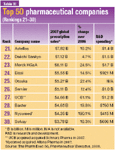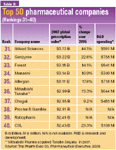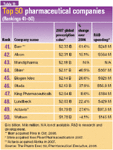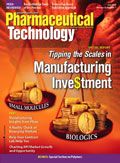Tipping the Scales in Manufacturing Investment
The pharmaceutical majors invest in biologics production capacity as they advance restructuring programs and build their pipelines
Pharmaceutical Technology's Third Annual Manufacturers' Rankings reveal several important trends reflected by the pharmaceutical industry's sales growth, manufacturing activity, and acquisitions in 2007 and 2008. Big Pharma continues to invest heavily in biologics by expanding production capacity and acquiring technology platforms. Companies are strengthening their pipelines through acquisitions of both biologics and select small-molecule drug candidates. Also, several major pharmaceutical companies are restructuring to reduce costs across their supply chains.

Stockbyte, getty images
The impetus behind this activity is clear: the rate of growth in the pharmaceutical industry continues to slow. The global pharmaceutical market increased 6.4% (as measured in constant US dollars) to $712 billion in 2007, according to IMS Health. This growth rate was down from the 7.1% rate achieved in 2006, when the global market reached $649 billion. Last year also marked the fourth consecutive year of single-digit revenue growth (see Table I). The North American market, which accounted for 45.9% of the global market in 2007, increased only 4.2% to $304.5 billion, and the European market increased 6.7% to $206.2 billion, according to IMS Health. Growth in emerging markets was robust, although these gains were from a small base (see story, "A Reality Check on Emerging Markets").

Table I: Global pharmaceutical sales
Big Pharma's investment activity
Table II outlines the rankings of the top 50 pharmaceutical companies by 2007 pharmaceutical sales, and a review of the top companies shows several major restructuring programs and a continued push to biologics.
Pfizer. Pfizer (New York) is continuing its multiyear strategy of manufacturing network rationalization and supply-chain optimization. Since the Pharmacia integration began in 2003, Pfizer has reduced the number of its manufacturing plants from 93 four years ago to 57, as of Mar. 31, 2008. This reduction reflects the acquisition of seven plants and the sites sold in 2006 as part of Johnson & Johnson's (New Brunswick, NJ) $16.6-billion acquisition of Pfizer's consumer healthcare business. By the end of 2009, Pfizer plans to reduce the number of its manufacturing plants to 43. This reduction will represent a 50% decrease in plants and a 35% decrease in manufacturing employees compared with 2003 levels.

Table II: Top 50 pharmaceutical companies (Rankings 1â20)
Pfizer is also rationalizing capacity based on its decision to exit the development and commercialization of its inhaled insulin product "Exubera" for which the company took a one-time pretax charge of $2.8 billion in October 2007. Pfizer plans to sell the Frankfurt, Germany, plant that manufactured the product. Pfizer had jointly owned the plant with Sanofi-Aventis (Paris) and wholly acquired the plant in 2006 as part of Pfizer's acquisition of the rights to manufacture and sell Exubera. By mid-2009, Pfizer plans to close its Terre Haute, Indiana, manufacturing plant. The plant manufactured Exubera.
As part of its research and development (R&D) productivity initiative, Pfizer announced in January 2007 the closure of six R&D facilities. As of Mar. 30, 2008, the company had closed R&D facilities in Mumbai, India, and Plymouth Township, Michigan. The company also has significantly scaled back operations in Ann Arbor and Kalamazoo, Michigan; Nagoya, Japan; and Amboise, France.
As it scales back, Pfizer is strengthening its position in biologics. The company is investing EUR 190 million ($294 million) for a process-development and small-scale production facility for biologics in Shanbally, Ireland. The facility will be located on a 30-acre site adjacent to Pfizer's existing facility in Ringaskiddy. The facility is scheduled to be completed and fully commissioned by the end of 2009. The move complements Pfizer's creation of the Pfizer Biotherapeutics and Bioinnovation Center in late 2007. Based in San Francisco, the center oversees a consortium of units and collaborations with the academic, biomedical, biotechnology and venture-capital communities and collaborates with Pfizer Global Research and Development.
Pfizer enhanced its drug pipeline through several recent acquisitions. In 2008, it acquired Serenex (Durham, NC), whose key product is the anticancer therapy "SNX-5422," an oral heat-shock protein 90 inhibitor in Phase I trials. In 2008, Pfizer obtained an 85% stake in the biopharmaceutical company Encysive Pharmaceutical (Houston, TX). Encysive's lead product is "Thelin" (sitaxsentan sodium) for treating pulmonary arterial hypertension. In January 2008, Pfizer bought CovX (San Diego. CA), a biotherapeutics company specializing in preclinical oncology and metabolic research. CovX also developed technology that links therapeutic peptides to an antibody scaffold to allow half-life extension to improve bioavailability and optimize the dosing regimes of peptide therapeutics.

Table II: Top 50 pharmaceutical companies (Rankings 21â30)
To enhance its position in vaccines, Pfizer purchased Coley Pharmaceutical (Wellesley, MA) in early 2008. In 2008, it formed a pact with Avant Immunotherapies (Needham, MA) for an exclusive global license for "CDX-110," an experimental therapeutic vaccine, and exclusive rights to EGFRvIII vaccines. EGFRvIII is a functional variant of the epidermal growth factor receptor (EGFR), a protein validated as an anticancer target. Also, in 2007, Pfizer acquired BioRexis Pharmaceutical (King of Prussia, PA). The company has developed drug candidates to treat diabetes and technology that uses serum protein transferrin as a scaffold for developing improved versions of peptides, proteins, and antibody-like molecules.
GlaxoSmithKline. In October 2007, GlaxoSmithKline (GSK, London) announced a £1.5- billion ($2.9-billion) operational excellence program to improve the effectiveness and productivity of its operations and achieve annual pretax savings of £700 million ($1.34 billion) by 2010. These savings are designed to mitigate lower earnings resulting from generic competition and declining sales of the antidiabetes product "Avandia" (rosiglitazone maleate). As part of that initiative, GSK will reduce the number of sites in its manufacturing network and simplify processes to reduce overcapacity and increase outsourcing.
In March 2008, GSK opened a SGD 115-million ($84-million) pilot plant in Singapore. GSK is also building a SGD 300-million ($219-million) vaccine-manufacturing plant in Singapore, which is scheduled to be operational in 2010. GSK is investing more than EUR 500 million ($774 million) in its St-Amand-Les-Eaux, France, vaccine-manufacturing plant to increase formulation, filling, freeze-drying, and packaging production. The facility is expected to be operational in 2011. In 2007, GSK announced an investment of EUR 250 million ($387 million) over five years in its production site in Currabinny, Ireland, to manufacture products such as lapatinib, the active ingredient in 'Tykerb." GKS is also investing EUR 30 million ($47 million) to expand an over-the-counter manufacturing facility in Dungarvan, Ireland, and recently completed a EUR 23 million ($36 million) granulation and compression facility.
In June 2008, the company acquired Sirtis Pharmaceutical (Cambridge, MA) for $720 million. Sirtis develops small-molecule drugs based on sirtuins, a class of enzymes believed to be involved in the aging process. In December 2007, GSK bought Reliant Pharmaceuticals (Liberty Corner, NJ) for $1.65 billion. The move gives GSK rights to the cardiovascular drug "Lovaza" (omega-3-acid ethyl esters). GSK also formed a drug-development pact with Santaris Pharma (Bøge Allé, Denmark). Santaris develops oligonucleotide drugs based on locked nucleic acid, a proprietary ribonucleic-acid analogue.

Table II: Top 50 pharmaceutical companies (Rankings 31â40)
Sanofi-Aventis. Sanofi-Aventis made no major asset disposals in 2007, and its principal investments were by its vaccine subsidiary, Sanofi Pasteur (Lyon, France). In 2007, Sanofi Pasteur increased the capacity of its Lyon manufacturing facility by 4800 m2 . Sanofi Pasteur is constructing a formulation-and-filling facility in Val de Reuil, France, to boost filling capabilities, mainly for influenza vaccines. In 2007, Sanofi completed the construction of a new $150-million, 140,000-ft2 influenza vaccine-manufacturing facility in Swiftwater, Pennsylvania. The new facility doubles the site's capacity to more than 100 million doses of influenza vaccine per year. The facility is projected to come on line in late 2008 or early 2009, following licensing by the US Food and Drug Administration. Sanofi also was awarded a $77.4-million contract by the US Department of Health and Human Services (HHS) to retrofit its existing influenza vaccine-manufacturing facility to switch to pandemic vaccine manufacture at HHS's request. Sanofi Pasteur is contributing $25 million to the project. The retrofit is scheduled to begin when the company's new influenza vaccine-manufacturing facility is licensed by FDA and is operational. Sanofi is building an influenza vaccine-manufacturing facility in Shenzhen, China. The facility will produce pandemic influenza vaccine and is scheduled to be completed and operational by 2012. Sanofi is further investing C$100 million ($98 million) in a 165,000-ft2 vaccine R&D facility in Toronto, which is scheduled for occupancy in 2010.
In December 2007, Sanofi-Aventis opened a 2600-m2 center in Goa, India, for analytical and formulation development. The facility is the company's first pharmaceutical-development center in Asia and its single largest investment in India to date.
Sanofi made several moves to enhance its position in biologics. In 2007, the company acquired the rights to "TroVax," a therapeutic cancer vaccine, from Oxford BioMedica (Oxford, UK). It partnered with Acambis (Cambridge, MA) to develop a vaccine against West Nile virus. Also in 2007, Sanofi increased its stake to 19% in the biopharmaceutical company Regeneron Pharmaceuticals (Tarrytown, NY), a developer of therapeutic human antibodies, and agreed to fund as much as $475 million in research over the next five years. Earlier this year, Sanofi received an exclusive worldwide license from Dyax (Cambridge, MA) for developing the fully human monoclonal antibody "DX-2240" and obtained an nonexclusive license to Dyax's proprietary antibody phage-display technology.
Novartis. Novartis (Basel, Switzerland) is implementing its "Forward" initiative, a program announced in December 2007 that is designed to achieve pretax annual cost savings of $1.6 billion by 2010. The program involves site closures and eliminating approximately 2500 full-time equivalent positions. As part of that initiative, some consumer-health division's product supply chains will be restructured to optimize capacity utilization. Research activities in the Novartis Institutes for BioMedical Research (NIBR) in Vienna and Tsukuba, Japan, will be phased out during 2008, and those facilities will be closed.

Table II: Top 50 pharmaceutical companies (Rankings 41â50)
Also, in 2007, Novartis divested its Gerber baby food business to Nestlé (Vevey, Switzerland) for $5.5 billion, the final step in a divestment program to focus the group's strategy on healthcare and pharmaceuticals. Novartis had earlier sold its medical nutrition business to Nestlé for $2.5 billion. Novartis also sold its rights and transferred a related manufacturing facility for "Betaseron" (interferon beta-1b) to Bayer Schering Pharma (Berlin) for $200 million and received rights to manufacture its own version of Betaseron beginning in 2009.
Novartis has two major biologics expansions underway. The company is investing $700 million in a new cell-culture production facility in Singapore to support clinical and commercial production of biopharmaceuticals, primarily antibodies. The proposed facility is expected to be operational in 2012 and represents Novartis's single largest investment in manufacturing capacity in the company's history. Also, in 2007, Novartis began work on its $600-million cell-culture manufacturing site in Holly Springs, North Carolina. In addition, the company formed a new biologics unit.
Also in 2007, Novartis completed a new $180-million tablet-manufacturing plant in Singapore. The plant is expected to be fully operational in 2009. The company invested $153 million in its production facility in Grimbsy, United Kingdom, and an additional $123 million in its production facility in Basel-Schweizerhalle, Switzerland, to increase capacity to support production of "Tekturna"/"Rasilez" (aliskiren). The Ciba Vision business unit of Novartis's consumer-healthcare business opened a new $131-million manufacturing facility in Johor, Malaysia. The facility will produce the company "Air Optixo/O2Optix" breathable contact lenses.
In April 2007, NBIR opened a 5000-m2 R&D center in Shanghai, and plans to build a larger 40,000-m2 R&D facility there that will house roughly 400 R&D scientists. An initial investment of $100 million was budgeted for the two facilities.
In June 2008, Novartis agreed to buy Protez Pharmaceuticals (Malvern, PA) for $100 million up-front and as much as an additional $300 million. With the acquisition, Novartis gains the North American and European rights to PZ-601, a carbapenem antibiotic in clinical development. In April 2008, Novartis agreed to acquire a majority stake in the eye-care company Alcon (Hunenburg, Switzerland) under a two-step purchase plan. The first step involves Novartis buying a 25% stake in Alcon for $11 billion, which is expected to be completed in the second half of 2008. The second step provides rights for Novartis to acquire from Nestlé, Alcon's parent company, the remaining 52% held by Nestlé between January 2010 and July 2011 for as much as $28 billion. In July 2007, Novartis formed a strategic alliance with Intercell (Vienna), a vaccines developer, and increased its stake in the company to 16.2%.
AstraZeneca. In 2007, AstraZeneca (London) strengthened its position in biologics with its $15.6-billion purchase of MedImmune (Gaithersburg, MD). MedImmune has biologics-manufacturing capacity of more than 30,000 L planned by 2010, with the potential to increase capacity to as much as 60,000 L with further investment. Also in 2007, AstraZeneca bought a 66,000-ft2 biologics-manufacturing facility in Montreal from DSM Biologics (Heerlen, The Netherlands). The facility will manufacture antibody-drugs for clinical development. Full-scale production is projected to begin in 2009.
AstraZeneca is continuing a major restructuring program to achieve annual cost savings of $1.4 billion by 2010. The program is in addition to the productivity initiatives announced by AstraZeneca at the end of 2006, which included eliminating 3000 employees in manufacturing and, in mid-2007, additional staff reductions. As part of an ongoing review of its manufacturing facilities, the company announced the sale of facilities in Monts, France; Plankstadt, Germany; Indonesia; and South Africa in 2007. The company also announced plans to close a packaging site in Canada.
AstraZeneca invested in a new R&D center in Shanghai, as part of a larger $100-million R&D package. It also opened a $15-million process R&D laboratory in Bangalore, India, in 2007. The company is investing in a new $120-million process R&D laboratory at its Macclesfield site in Cheshire, United Kingdom. The facility is projected to begin operations in mid-2009.
Johnson & Johnson. In October 2007, Johnson & Johnson (New Brunswick, NJ) announced a restructuring program that consolidates certain operations in its pharmaceuticals segment and eliminates 4400 positions company-wide; 1400 positions were eliminated in 2007. The move is expected to result in annual pretax cost savings of $1.3–1.6 billion for 2008.
Merck. Merck & Co. (Whitehouse Station, NJ) is continuing a company-wide restructuring that was first announced in 2005. The plan includes a new supply strategy by Merck's manufacturing division to be implemented through 2008. As of Mar. 31, 2008, Merck had sold or closed five manufacturing sites and two preclinincal sites and eliminated 8100 positions worldwide. Merck expects that the first phase of the global restructuring effort will yield pretax savings of $4.5–5 billion through 2010.
Merck is investing EUR 200 million ($309 million) in a vaccine facility in Carlow, Ireland, which is scheduled for completion in 2011. Earlier this year, Merck completed construction of a new $300-million vaccine-manufacturing plant in Durham, North Carolina. The facility is projected to be licensed and supplying vaccines in 2009. Merck is investing an additional $100 million in the Durham facility to add a sterile-processing facility, quality-testing laboratories, and a packaging line, scheduled to be completed by 2010. Merck is investing another $300 milllion in the facility for bulk-vaccine manufacturing capacity and utility, warehouse, and administrative infrastructure, scheduled for completion in 2011. The company also is building an EUR 100-million ($155-million) formulation R&D and solid-dosage manufacturing facility in Ballydine, Ireland.
In 2007, Merck acquired NovaCardia (San Diego, CA) for $366.4 million. NovaCardia's lead late-stage candidate is rolofylline for treating acute heart failure. Merck also partnered with Dynavax (Berkeley, CA) to develop an investigational hepatitis B vaccine and formed an R&D pact with GTx (Memphis, TN) for developing selective androgen receptor modulators.
Roche. In January 2008, Roche (Basel) announced investments of CHF 280 million ($268 million) to expand its biotechnology R&D activities in Penzberg, Switzerland, and CHF 150 million ($144 million) for expanding syringe-filling capabilities at its facilities in Mannheim, Germany, and Kaiseraugst, Switzerland. The company also opened a new biotechnology production center in Basel in May 2007. The facility will produce "Avastin" (bevacizumab). Delivery of the first batch of Avastin from Basel is scheduled for 2009.
Roche bought the Piramed (Slough, UK) in May 2008. Piramed is developing anticancer therapies that target P13-kinase. Last year, Roche formed a major alliance with Alnylam Pharmaceuticals (Cambridge, MA) that provides Roche access to Alnylam's ribonucleic-acid interference technology.
Wyeth. Earlier this year, Wyeth launched "Project Impact," a company-wide program designed to address short-term fiscal challenges, particularly from the launch of generic versions of "Protonix" (pantoprazole), and longer-term strategic redesign. The measure will include productivity initiatives in R&D, manufacturing, commercial, and administrative functions.
In October 2007, Wyeth announced plans to invest EUR 24 million ($37 million) for a new center for pharmaceutical development at its solid-dosage manufacturing facility in Newbridge, Ireland. It also acquired Haptogen (Aberdeen, Scotland), a company specializing in protein optimization and drug discovery.
Eli Lilly. In May 2008, Eli Lilly (Indianapolis, IN) completed a 475,000-ft2 bioproduct R&D laboratory, the third of three facilities that make up its Indianapolis biotechnology complex. The complex also includes a 250,000-ft2 bioproduct pilot plant and a 10,000-ft2 research support facility, which were completed in 2006. The construction of the three buildings and Eli Lilly's 2004 acquisition of Applied Molecular Evolution (San Diego), which conducts protein optimization research, represents a total biotechnology investment of $1 billion. In April 2008, the company broke ground for a EUR 400-million ($619-million) biopharmaceutical manufacturing facility in Kinsale, Ireland.
Eli Lilly is streamlining manufacturing in Indianapolis. The move affects sites producing the active ingredients for Lilly's insulin products "Humalog" and "Humulin" and for its osteoporosis drug "Forteo" (teriparatide recombinant human).
Key recent moves by Lilly include: the $2.3-billion acquisition of ICOS (Bothell, WA) in early 2007; a strategic alliance with MacroGenics (Rockville, MD) to develop the humanized monoclonal antibody, teplizumab, in October 2007; and a licensing and development agreement, announced in December 2007, with BioMS Medical (Edmonton, Alberta, Canada) for a synthetic peptide to treat multiple sclerosis.
Bristol-Myers Squibb. As part of its goal of transforming itself into a biopharmaceutical company, Bristol-Myers Squibb (BMS, New York) announced in December 2007 a strategy and productivity initiative that is expected to generate pretax annual cost savings of $1.5 billion by 2010. The plan involves reducing the number of its manufacturing facilities by more than 50% by the end of 2010. BMS announced the closure of several manufacturing facilities, which include ones in Barceloneta and Mayaguez, Puerto Rico. Also, BMS plans to reduce total headcount company-wide by 10% by 2010.
BMS is proceeding with the construction of a $750-million bulk-biologics manufacturing facility in Devens, Massachusetts. The facility is expected to be operationally complete by 2009. BMS expects to submit the site for regulatory approval in 2010 and begin commercial production in 2011.
Schering-Plough. In April 2008, Schering-Plough announced a productivity-transformation program with a goal of achieving $1.5 billion in annual savings, 80% of which will be completed by the end of 2010. The company plans to reduce the number of its plants globally and create more focused and high-efficiency plants by 2012. The move follows the company's EUR 11-billion ($17-billion) acquisition of Organon Biosciences (Oss, The Netherlands) in 2007.

Drug Solutions Podcast: A Closer Look at mRNA in Oncology and Vaccines
April 30th 2024In this episode fo the Drug Solutions Podcast, etherna’s vice-president of Technology and Innovation, Stefaan De Koker, discusses the merits and challenges of using mRNA as the foundation for therapeutics in oncology as well as for vaccines.
Pharmaceutical Tariffs Are Imminent: How Industry is Bracing for Impact
April 16th 2025On April 14, 2025, the Trump Administration launched a national security-driven investigation into pharmaceuticals, a move that will likely result in tariffs being placed on pharmaceutical drugs, ingredients, and other components that are imported from outside of the United States.